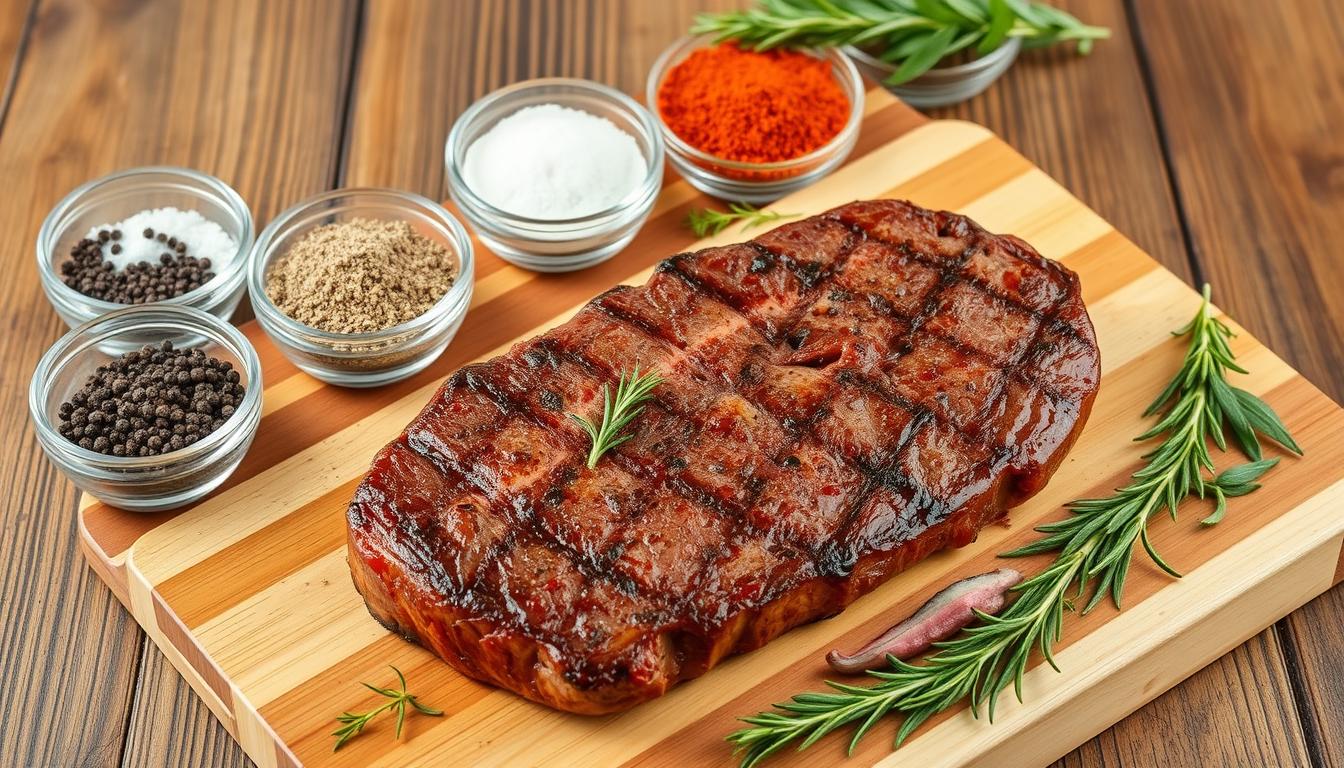We’re about to make your grilling better with expert steak seasoning tips. Our guide will help you make delicious, restaurant-quality steaks at home. You’ll learn about the best flavor enhancers and how to apply them.
Ready to learn how to make the perfect grilling blend? We’ll show you key ingredients that enhance your meat’s flavor. Plus, we’ll teach you when to season for the best taste. These tips are for everyone, whether you’re new to grilling or a pro.
Understanding the Basics of Steak Seasoning
Learning about steak seasoning can really improve your cooking. We’ll look at how flavors develop, the importance of salt, and when to season. These tips will make your steaks taste amazing every time.
The Science Behind Flavor Development
Steak seasoning is more than just taste. It’s a chemical process. When you use a dry rub or flavor enhancer, it starts reactions on the meat’s surface.
These reactions break down proteins. This creates new flavor compounds that make the steak taste better.
Salt’s Critical Role in Meat Preparation
Salt does more than add flavor. It changes the meat. It pulls out moisture, which then mixes with the salt.
This brine is then soaked back into the meat. It seasons the steak from the inside and makes it taste better.
Timing Your Seasoning Application
When you season your steak is very important. For thin cuts, seasoning right before cooking is best. Thicker steaks need seasoning earlier, so flavors can go deeper.
Let’s see how it works:
| Timing | Thin Cuts ( | Thick Cuts (> 1 inch) |
|---|---|---|
| Just Before Cooking | Crisp exterior, even flavor | Surface flavor only |
| 1 Hour Before | Slightly overseasoned | Good flavor penetration |
| 24 Hours Before | Too salty, dry texture | Deep flavor, tender meat |
By learning these basics, you’re well on your way to becoming a steak seasoning pro. Try out different dry rubs and flavor enhancers to find your favorite mix.
Essential Ingredients for a Perfect Dry Rub Mix
Making the perfect steak dry rub is an art. It can make your beef taste amazing. Here’s a list of key ingredients for a tasty dry rub mix for your next grill.
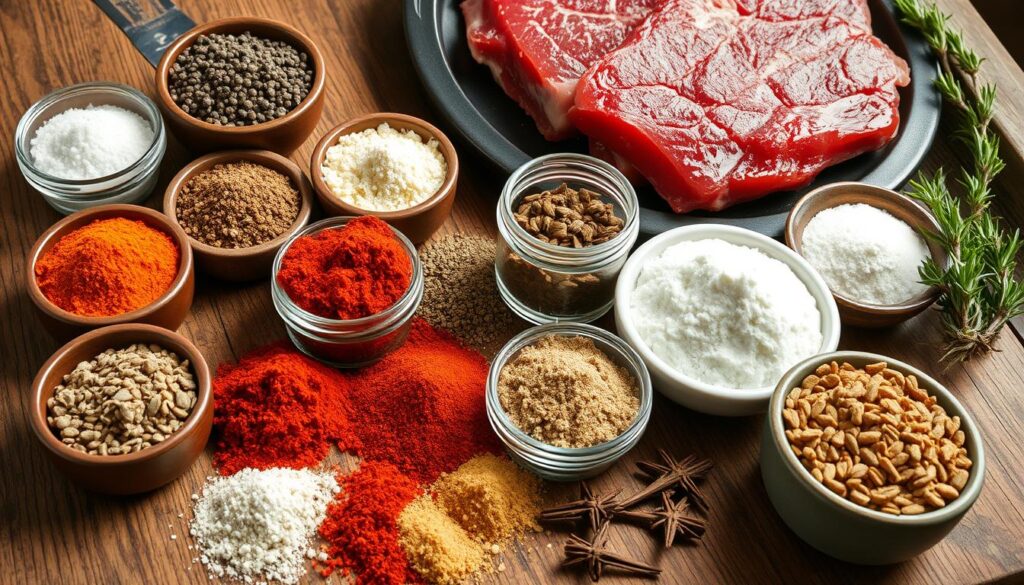
Salt is the base of any good beef seasoning. It brings out flavors and makes the meat tender. Mix it with freshly ground black pepper for a classic taste.
Garlic powder adds a deep, savory flavor to your mix.
For a balanced mix, try these spices:
- Paprika: Adds color and a bit of sweetness
- Onion powder: Goes well with garlic
- Brown sugar: Adds a sweet caramel taste
- Cumin: Brings a warm, earthy flavor
- Dried herbs: Thyme or rosemary for a complex aroma
Play with the amounts to make your own unique dry rub. The secret to a great mix is finding the right balance. Start with equal parts of the main ingredients and adjust as you like.
“A well-crafted dry rub can transform an ordinary steak into a mouthwatering masterpiece.”
Keep your homemade seasoning in an airtight container to keep it fresh. With these basics, you’re ready to grill like a pro!
Creating Your Signature BBQ Seasoning Blend
Making your own BBQ seasoning is fun. It lets you make your grilling special. Let’s explore how to create a spice rub that will make your steaks unique.
Base Spices for Traditional Blends
Any good grilling blend starts with classic spices. Salt and black pepper are the base. Paprika adds color and a bit of sweetness. Garlic powder and onion powder add depth to your seasoning.
| Base Spice | Flavor Profile | Recommended Amount |
|---|---|---|
| Salt | Enhances overall flavor | 2 tablespoons |
| Black Pepper | Adds heat and bite | 1 tablespoon |
| Paprika | Provides color and mild sweetness | 2 tablespoons |
| Garlic Powder | Offers savory depth | 1 tablespoon |
| Onion Powder | Brings subtle sweetness | 1 tablespoon |
Adding Heat Elements
To add heat, think about using cayenne pepper or chili powder. These can make your seasoning spicy. Start with a little and adjust to your liking.
Incorporating Aromatic Herbs
Aromatic herbs can take your seasoning to the next level. Try dried thyme, rosemary, or oregano. They enhance the meat’s flavor and add sophistication.
Mix everything well to make your signature seasoning. Keep it in an airtight container to stay fresh. With time, you’ll get it just right, making every steak a delight.
Professional Techniques for Applying Meat Marinade
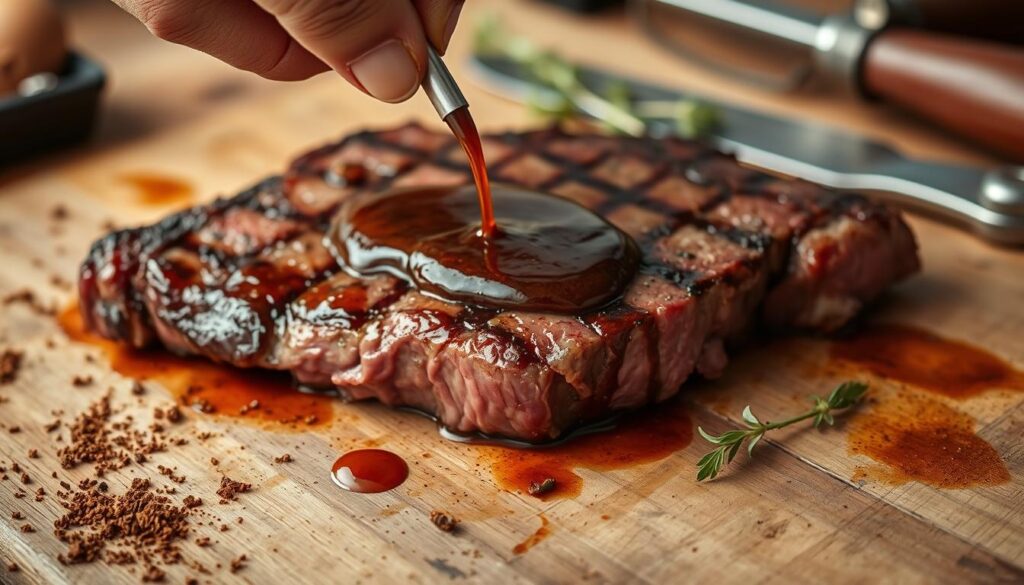
Learning to apply meat marinade can make your steak amazing. We’ve got expert tips to help you get it right.
First, pick the right container. Glass or ceramic is best because they don’t react with acidic ingredients. Metal containers can change the flavor of your marinade.
Timing is important for marinades. Most cuts need 2-8 hours. Thinner cuts need less, while thicker ones need more. Don’t marinate too long, or the meat will get mushy.
“A well-applied marinade acts as both a tenderizer and a flavor enhancer, transforming your steak into a culinary masterpiece.”
To get even coverage, put your steak in a sealable plastic bag with the marinade. Squeeze out air and massage the bag. This makes sure all sides are coated.
For more flavor, try texturizing techniques with your marinade. This mix can give your steak a unique taste.
| Cut of Steak | Recommended Marination Time | Ideal Marinade-to-Meat Ratio |
|---|---|---|
| Flank Steak | 4-6 hours | 1/2 cup per pound |
| Sirloin | 2-4 hours | 1/3 cup per pound |
| Ribeye | 1-2 hours | 1/4 cup per pound |
Marinades are great for flavor, but they don’t go deep into the meat. For deeper flavor, use a dry steak seasoning rub too.
The Art of Montreal Steak Seasoning
Montreal steak seasoning is a favorite spice rub that makes beef taste amazing. It has a special history and flavor that makes it stand out.
Origins of a Classic
The story of Montreal steak seasoning started in the 1940s at Schwartz’s Deli in Montreal, Canada. A grill master made this spice rub to match Romanian steak house flavors. It became popular fast and spread across North America.
Key Ingredients
Montreal steak seasoning has:
- Coarse salt
- Cracked black pepper
- Garlic powder
- Paprika
- Dried onion
- Crushed red pepper flakes
- Dried coriander
- Dried dill
This mix gives a bold, savory taste that goes well with beef.
Application Tips
To use Montreal steak seasoning well:
- Pat the steak dry before seasoning
- Apply generously to both sides of the meat
- Press the spices into the steak
- Let it sit for 30 minutes before cooking
This way, the flavors get into the meat, making a perfectly seasoned steak.
Whether grilling a ribeye or pan-searing a sirloin, Montreal steak seasoning adds restaurant-quality flavor to your cooking.
Common Mistakes to Avoid When Seasoning Steaks
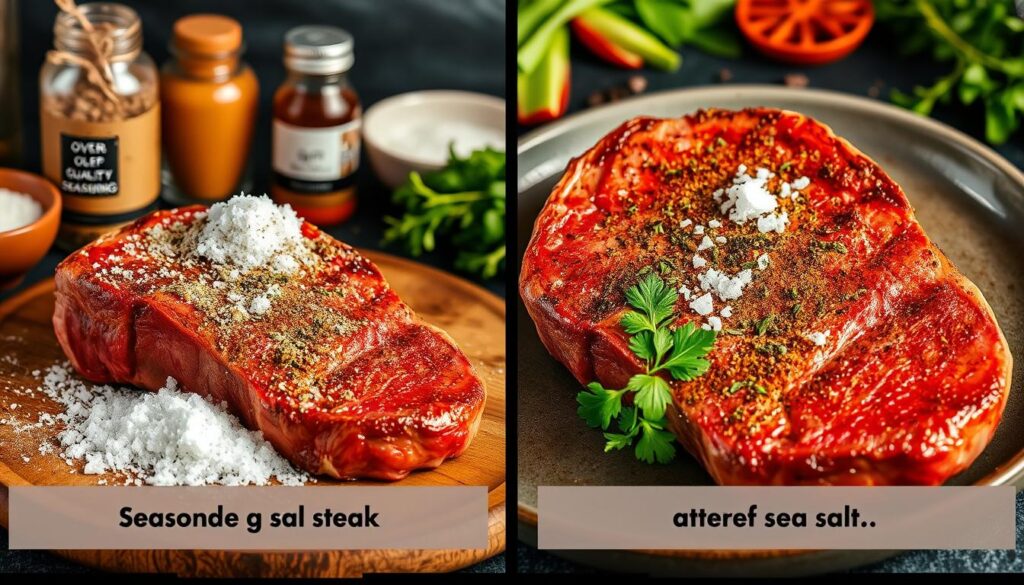
We’ve all been there – excited to grill the perfect steak, only to end up with a disappointing result. Let’s explore some common pitfalls in steak seasoning and how to sidestep them for mouthwatering results every time.
Over-seasoning is a frequent error. While a flavorful dry rub can elevate your steak, too much can overpower the meat’s natural taste. A good rule of thumb: use about 1 tablespoon of seasoning per pound of meat.
Timing is key. Seasoning too early can draw out moisture, leaving your steak dry. On the flip side, seasoning too late doesn’t allow flavors to penetrate. Aim to apply your grilling blend 30-40 minutes before cooking.
Using stale spices is another misstep. Old spices lose their potency, resulting in bland steaks. Keep your steak seasoning fresh by storing it in an airtight container away from heat and light.
| Mistake | Consequence | Solution |
|---|---|---|
| Over-seasoning | Overpowering flavor | Use 1 tbsp per pound of meat |
| Poor timing | Dry or under-flavored steak | Season 30-40 minutes before cooking |
| Stale spices | Bland taste | Store properly and replace regularly |
Neglecting to pat the steak dry before seasoning is a common oversight. Excess moisture can prevent your dry rub from adhering properly. Always pat your steak dry with paper towels before applying your favorite seasoning blend.
By avoiding these mistakes, you’ll be well on your way to grilling steaks that are perfectly seasoned and bursting with flavor.
Advanced Grilling Blend Combinations
Exploring global flavors can make your grilling blend better. We’ve picked some unique mixes from around the world. They will add to your steak dry rub collection.
Mediterranean-Inspired Blends
Mediterranean flavors add a bright, herbaceous taste to your grilling blend. Mix dried oregano, thyme, rosemary, and garlic powder with lemon zest. This makes a zesty steak dry rub. It’s great with olive oil-brushed beef.
Asian Fusion Seasonings
Asian-inspired spice rubs give a new twist to steak seasonings. Mix five-spice powder, brown sugar, ginger, and a pinch of star anise. This blend is perfect for both beef and pork.
Latin American Flavor Profiles
Latin American seasonings add heat and depth to your grilling blend. Mix chili powder, cumin, coriander, and smoked paprika for a strong flavor. Add cocoa powder for richness, like traditional seasoning blends but with a twist.
| Blend Origin | Key Ingredients | Best Cuts |
|---|---|---|
| Mediterranean | Oregano, thyme, lemon zest | Sirloin, flank steak |
| Asian Fusion | Five-spice, ginger, star anise | Ribeye, strip steak |
| Latin American | Chili powder, cumin, cocoa | Skirt steak, hanger steak |
Try these global grilling blends to find new favorites. Impress your guests with unique flavors.
Seasoning Tips for Different Cuts of Beef
Not all beef cuts are the same. The right seasoning depends on the cut’s unique traits. Let’s see how to boost flavors for different beef types.
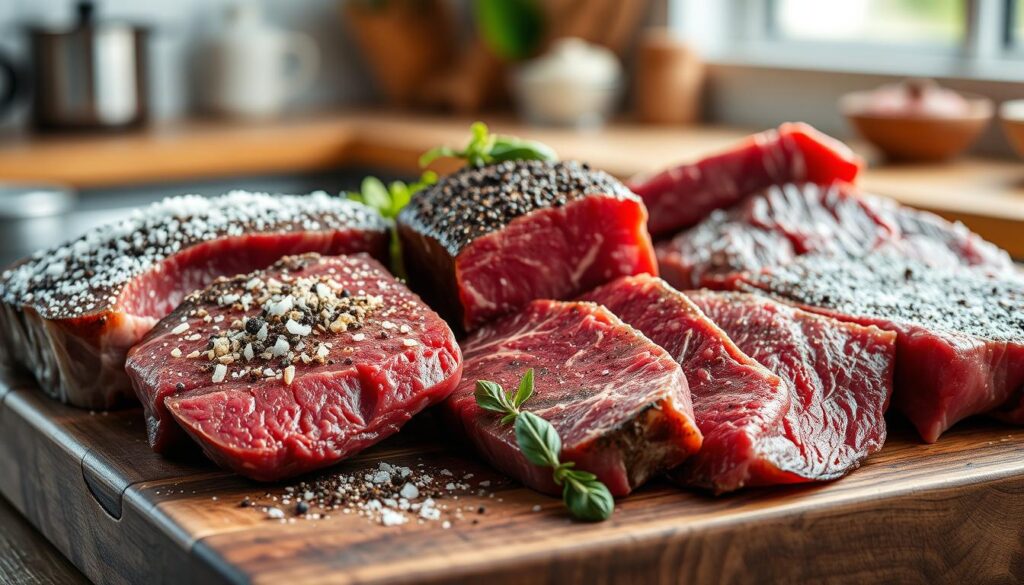
Ribeye steaks, with their marbling, need a simple seasoning. Salt, pepper, and garlic powder enhance their natural taste. Sirloin, being leaner, requires a bolder seasoning to add depth.
Filet mignon, known for its tenderness, needs a light touch. A sprinkle of salt and fresh herbs is enough. Flank steak, being tougher, benefits from a marinade to add flavor and tenderize it.
| Cut | Seasoning Approach | Flavor Profile |
|---|---|---|
| Ribeye | Salt, pepper, garlic powder | Rich, savory |
| Sirloin | Bold spice rub | Robust, complex |
| Filet Mignon | Light salt, fresh herbs | Delicate, subtle |
| Flank Steak | Marinade | Tangy, tenderized |
Remember, the cut’s thickness matters too. Thicker steaks need more time for flavors to soak in. Apply seasoning early and let it rest before cooking.
By adjusting seasoning for each cut, you’ll make your beef dishes even more flavorful and tender.
Storage and Shelf Life of Custom Spice Rubs
Making your own spice rub or BBQ seasoning is rewarding. But, keeping it fresh is key. Let’s look at how to keep your dry rub mix fresh and flavorful.
Proper Container Selection
Use airtight containers for your spice rub. Glass jars or metal tins are good choices. Stay away from plastic, as it can pick up smells and tastes. Make sure to label each container with the blend name and date.
Environmental Considerations
Keep your BBQ seasoning in a cool, dry spot. Avoid direct sunlight. Heat and moisture can spoil spices fast. A pantry or cupboard is perfect. Don’t store near the stove or other heat sources.
Freshness Indicators
Regularly check your dry rub mix for signs of aging. Fresh spices should have bright colors and strong smells. If the smell is weak or the color has dulled, it’s time to make more.
| Spice Rub Type | Shelf Life | Storage Tips |
|---|---|---|
| Salt-based | 1-2 years | Keep in dark, cool place |
| Herb-heavy | 6-12 months | Store in freezer to extend life |
| Chili-based | 1 year | Check for color changes |
By following these tips, your homemade spice rub will stay fresh and flavorful. Enjoy it for all your grilling needs.
Conclusion
Learning how to season steak is essential for better grilling. We’ve looked at many ways to make your steaks taste amazing. From the science of seasoning to making your own special blend, these tips will change your cooking.
The right seasoning can really change a steak. You might like a classic Montreal mix or something more peculiar. Try different spices and herbs to find your favorite taste.
Keep practicing and remember to store your seasonings right. Soon, your steaks will taste as good as those from fancy restaurants. So, get your grill ready, pick your favorite seasoning, and start making perfect steaks!

